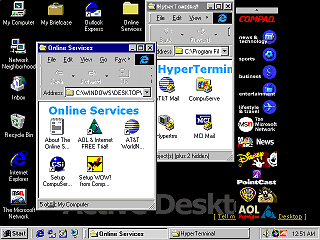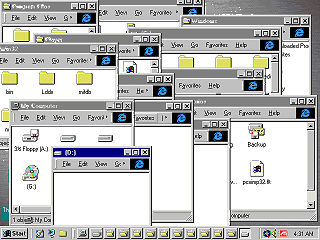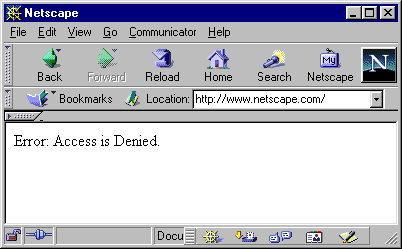Active webpage from the 90's
Live 90's page ---> http://toastytech.com/evil/ieisevilstory.html

People were happy with Windows 95 and Microsoft.
It was a happy time for PC users. Microsoft had just delivered Windows 95, an incredibly vast improvement over windows 3.1 and DOS.
Windows 95 finally brought PC users a crisp, clean, well thought out, user interface comparable to that of the Apple Macintosh while also providing full backwards compatibility with previous versions of DOS and Windows. On the technical side Microsoft pulled off a near miracle by implementing a 32-bit API compatible with their NT operating system on top of "16-bit" Windows.

Windows 95 was also heavily about choice. One could choose to use the Windows 3.1 Program Manager shell, networking was optional, and all accessories were optional via the new Add/Remove Programs control panel item.
Windows 3.1 Program Manager


Compared to Windows 3.1, switching to Windows 95 was just a no-brainer. Files on the desktop, no more futzing around with the program manager, seamless networking, and a desktop like MacOS 1.0 or the Xerox Star of more than 10 years earlier.
Browsers were ordinary applications.
What is a web browser? A web browser is an application that retrieves documents from a network, and renders them on your screen.
Netscape Box.Internet Explorer Box
Many people did not need a web browser. Internet access was still new, and a great many people got along fine without it.
Web browsers at the time were commercial products that people paid for. Like any other big name software package, you would go to the store, pick up a box, pay for it, bring it home, and install the application software on your computer.
There was a twist: Netscape's primary consumer targets were companies and enterprises, so they made their software downloadable, and licensed it at no cost for personal use.
Somewhere around this point, people began spewing mindless drivel about how browsers would somehow magically replace operating systems eventually, and how in the future all applications would be "web based". This, of course, got Microsoft's attention.
Being a little late to the game, Microsoft licensed a copy of Mosaic, named it Microsoft Internet Explorer, and released it as an optional part of the Windows 95 "plus" pack.
The floppy disk version of Windows 95 did not include Internet Explorer. But the alarm bells should have sounded when Microsoft added IE 1 to the CD-Rom version as a non-optional component. Likely this went unnoticed because Windows 3.1 had no add/remove capability, so people were still used to manually deleting programs like this.
Windows 95 OEM Service Release 2 included IE 3 also as a non-optional component, but still technically removable despite having more componetized DLLs.
Microsoft forced people to install their browser, and other tasteless things.
Then the browser war got really fierce.
Microsoft released Internet Explorer 4 - a very buggy, bloated browser that encouraged the use of the highly insecure ActiveX. By itself, the release of yet another web browser would have been no big deal, but how Microsoft pushed it on to consumers was unacceptable.
First, Installing IE 4 was a very invasive process. Other browsers, or indeed any normal application, would never touch system files or alter the way an operating system worked. IE 4, when installed on Windows 95 or NT 4, would replace or update many system files with its own special versions, which sometimes broke functionality of other applications, and made it almost impossible to re-install these OSes once IE 4 was installed.
IE Desktop and Advertising

IE 4 by default also replaced the Windows 95/NT 4 desktop with its "Desktop Update" that added the following:
Used Internet Explorer to manage files instead of the standalone file manger.
Displayed folders as "web pages".
Added IE logos to every file browser window, and many other places.
"Favorites" bookmark menu and location/URL bar that always launched IE instead of the default browser.
Added the IE "Channel" bar with advertising links, right on the destkop!
Made IE look like it launched faster because 99% of it was already loaded in to RAM.
Slowed down other applications, and discouraged users from using other web browsers because IE was already loaded in to RAM.
IE 4 also began to replace Windows help files with "HyperHelp" help files that used IE to render the content.
And to add even more insult to injury, the IE 4 uninstaller would only "revert" to any previous version of IE instead of cleanly uninstalling, and even then it would leave behind a bunch of junk.
IEEEEEEEEEEEEEEEEEEEEEEEEEEEEEE!

It blows my mind that anyone would think that any of this was a good idea. But that did not matter to Microsoft, the intent was to push Netscape off of user's desktop and out of the marketplace.
Bundling, Bundling, Bundling! You have no choice!
Netscape was trying to get itself bundled with third party software and ISP software, but Microsoft had infinitely more influence and power, and chose to leverage all of it.

Microsoft began bundling or requiring Internet Explorer as a non-optional component of their software products. They even "convinced" many other software vendors to bundle Internet Explorer as well.
Productivity tools, games, utilities, and even device drivers began to require that Internet Explorer be installed in order to operate. Sometimes they embedded the HTML renderer in to their applications (never for any good reason), sometimes they used other IE related libraries, sometimes they simply required DLL updates that could have been obtained elsewhere, often they bundled IE-HyperHelp files instead of WinHelp help files.
And Microsoft's strategy to ram IE down everybody's throats pretty much covered all possible bases:
Home users: Windows 98
After the success of Windows 95, home users were likely to run out and buy Windows 98 upgrades or new computers with Windows 98. Windows 98 non-optionally included Internet Explorer 4 and the IE 4 desktop with all the horrors mentioned above. This meant that every new computer shipped with Windows also had to have IE. Because a browser was already installed, people were less likely to install another one.
And for those that thought it should be optional, Microsoft was dancing around proclaiming that IE was now an "integrated" part of the operating system, and could never, ever, ever be removed. At least until Shane Brooks came along with 98lite that could pretty well exorcise IE from Windows 98.
Corporate users: Outlook 98
For corporate workstations, that were less likely to upgrade to Windows 98, Microsoft released Outlook 98. Many businesses and organizations were and still are hooked on Exchange Server for their e-mail, and Outlook is pretty much the only application that can access the full functionality from an Exchange Server. Outlook 97 was actually a very fine product and did not require any web browser. To correct this oversight, Microsoft released a "Free" update to Outlook 98.
Outlook 98 used IE 4 to compose and render HTML e-mail messages (rather than just translating to RTF) as well as a summary page of messages, tasks, and calendar events called "Outlook Today". Everybody was perfectly happy to ignore the fact that this opened up Outlook to all of the bugs and exploits present in IE 4.
Those in charge of corporate networks typically have a kind of "allergy" to multiple installed applications that do the same thing. They may have been using Netscape, but now their new software requires IE to be installed as well. One of these browsers must go... guess which one?
NT Option Pack
NT 4 servers were the least likely to be upgraded because system administrators usually don't care about bells and whistles or new features as long as the existing system works. For these folks, Microsoft created the aptly named "Option" pack that installed IE4 as a mandatory part of an update to Internet Information Server. If you wanted or needed the latest version of IIS, you had to install IE 4!
Apple Macintosh
And as if forcing IE on all Windows users wasn't bad enough, Microsoft forced Apple to bundle IE for Mac as their default browser instead of Netscape. If Apple refused, Microsoft would discontinue MS-Office for Mac. Steve Jobs was loudly BOOED as he announced that IE would be the default browser.
Come on people! If a software product gets you booed at in front of thousands of your users, shouldn't that tell you there is something horribly, horribly, wrong with that product?
Internet / Intranet web sites
And dare I mention web sites that popped up all over the place that required IE, or gave other browsers an inferior experience?
Initially Microsoft gave incentives to many sites to use IE-only technology. Their web content generation tools, such as FrontPage, Microsoft Word, and PowerPoint were all designed to use IE-specific features. After IE became "standard" in businesses, intranet developers became lazy and only developed for IE.
Thankfully most public internet sites that were IE only have gone the way of the dodo bird, however there are still too many crufty old corporate intranet ones out there.
Sadly, Microsoft continues to crank out web based products that only work fully in IE.
OEMs (Original Equipment Manufacturers)
Just in case OEMs like Dell, or Compaq got any wise ideas about shipping their computers with a browser users actually wanted, Microsoft FORBADE them from removing/disabling IE or even just removing the IE desktop icon. It was either keep the icon, or Microsoft would stop selling Windows to them - and then see what happens.
Also, OEMs have a similar allergy to shipping multiple applications that do the same thing, because they must spend money providing "support" for both.
Networks
Why just go after the desktop when you can go after the networking infrastructure?
At the time, a common way to protect computers, filter, and optimize web traffic in a corporate network was to place users on an isolated network with all web access going through a "proxy" server. Microsoft produced their own product like this called "Microsoft Proxy Server" (later renamed to ISA Server), and many businesses were happy to use this.

Unlike a standard web proxy, Microsoft's web proxy defaulted to requiring a special secret "handshake" with the client, called NTLM authentication. Only Microsoft Internet Explorer knew how to perform this "handshake". The alternative was to send a standard unencrypted plain-text password over the network, which was a big no-go in this setup as the password used was typically the same as the user's Windows network login.
Once a company or organization implemented a Microsoft Proxy server, any non Internet Explorer browsers or Internet tools on that network would instantly stop working.

Netscape 4 using a MS Proxy Server
It wasn't until Mozilla Suite 1.4 (Netscape 7.1) that NTLM became natively available in any other browser. (and even then, only on Windows initially) But by that time the damage was long since done, and IE completely controlled corporate intranets.
The dust settles, the clouds clear.
All of this was more than enough to successfully squash Netscape like a bug. By the time IE 5 rolled out, Netscape was pretty much history in most people's minds.
Funny thing, once Netscape was out of the picture, MS pretty much let IE rot. IE 5.5, and 6.0 were minor updates. IE 6 went so long without any updates it became a cesspool for spyware, malware, and abusive advertisements. IE 5 for Mac was never significantly updated and eventually discontinued.
As luck would have it, some determined hackers kept working on the old Netscape code to create Mozilla and then Firefox, ultimately restoring some level of competition. We came dangerously close to being stuck with nothing but IE 6 for the rest of eternity!
In conclusion, people are finally beginning to understand the hard way:
Web Browsers really make poor client application runtimes for all but the most basic of things.
ActiveX is a security nightmare and counter to making cross-platform applications.
The web is a constantly changing and evolving standard separate from Microsoft or any specific operating system, as such implementing an application for just one specific browser and version with no intent to keep it updated is just asking for disaster.
Tying local help files or other local content to a "live" web browser that may change in functionality is a bad idea.
But, nobody ever listened to anything I have to say.
Congratulations @jasonvoorhees! You have completed some achievement on Steemit and have been rewarded with new badge(s) :
Click on any badge to view your own Board of Honor on SteemitBoard.
To support your work, I also upvoted your post!
For more information about SteemitBoard, click here
If you no longer want to receive notifications, reply to this comment with the word
STOP